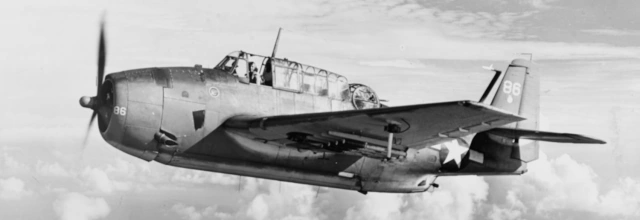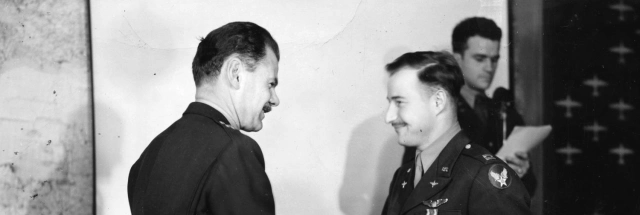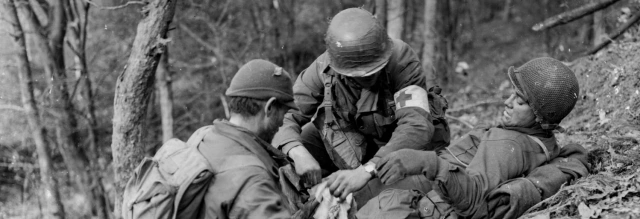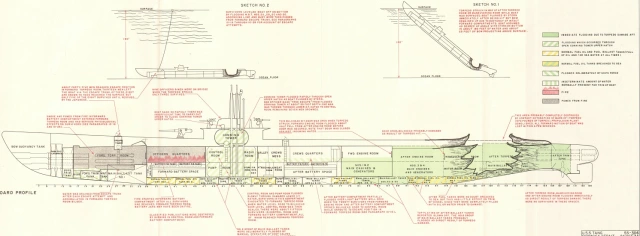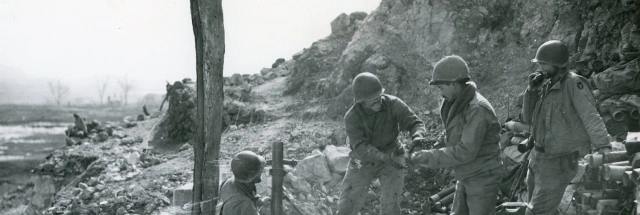| Home State | Civilian Occupation |
| Delaware | Clerk for the DuPont Company |
| Branch | Service Number |
| U.S. Army Air Forces | 32752255 |
| Theater | Unit |
| European | 838th Bombardment Squadron (Heavy), 487th Bombardment Group (Heavy) |
| Awards | Campaigns/Battles |
| Air medal, Purple Heart | 5 combat missions to France and Germany |
Early Life & Family
Harry Morris Hinkson was born at the Delaware Hospital in Wilmington on the evening of July 29, 1923. He was the third child of Harry Morris Hinkson, Sr. (a milk dealer, 1884–1973) and Mary Hinkson (née Ingram, 1886–1986). Hinkson grew up at 1022 Monroe Street in Wilmington. His father operated the Hinkson Dairy, later purchased by Hy-Point. He had two older sisters: Marguerite Hinkson (later Beach, 1909–1995) and Ruth Hinkson (later Hammond, 1912–2011). Hinkson was in the Wilmington High School band—his niece described him as “a talented trumpet player”—prior to graduation in 1941. He was also a member of the West Presbyterian Church.
When he registered for the draft on June 30, 1942, Hinkson was working as a clerk in the Purchasing Department at E. I. du Pont de Nemours and Company (better known as the DuPont Company) at 10th and Market Streets in Wilmington. The registrar described him as standing approximately five feet, eight inches tall and weighing 131 lbs., with brown hair and blue eyes.
U.S. Army Air Forces Training
Hinkson was drafted in early 1943. Although his enlistment data card is among approximately 13% that could not be digitized, Hinkson’s father wrote a detailed statement about his son’s training on a State of Delaware Individual Military Service Record in 1946. Family-supplied information on these forms sometimes contains errors and it is not possible to verify all details that the elder Hinkson supplied. However, the movements and dates seem generally consistent with information about the younger Hinkson’s career in other sources.
Hinkson’s father stated that his son was inducted into the U.S. Army in Camden, New Jersey, on February 23, 1943. Private Hinkson attended basic training at the U.S. Army Air Forces Miami Beach Training Center from March 7, 1943 – April 10, 1943. Two days later, he reported at the Stevens Hotel in Chicago, Illinois, a building that the U.S.A.A.F. had converted into a training center. That same day, he was promoted to private 1st class. Hinkson completed his assignment in Chicago on June 14, 1943.
On June 15, 1943, Private 1st Class Hinkson reported at the Army Air Forces Technical Training Center in Sioux Falls, South Dakota. It appears that Private 1st Class Hinkson completed a radio training course there. He departed Sioux Falls on November 13, 1943, arriving at Laredo Army Air Field, Texas, on November 16, 1943. Upon completing flexible gunnery school there, Hinkson was promoted to corporal on January 19, 1944.
Hinkson visited home before reporting to his next assignment. A September 11, 1944, Wilmington Morning News article stated:
While in Wilmington on a furlough last February, Sergeant Hinkson had planned to marry Miss Ann D. Clayton, daughter of Mr. and Mrs. George Clayton, 827 Morrow Street, but the couple decided to wait until he returned before announcing the engagement.
According to his father’s statement, Corporal Hinkson reported for duty in Salt Lake City, Utah, on February 11, 1944. According to research by Paul M. Webber, secretary of the 487th Bomb Group Association, it was around this time that Hinkson joined a Boeing B-17 Flying Fortress crew, led by 2nd Lieutenant Charlton A. Deuschle (1916–1979), at Camp Kearns, located near Salt Lake City. According to the elder Hinkson’s statement, his son was stationed at Sioux City Army Air Base, Iowa, between March 25, 1944 – June 10, 1944, for combat crew training.

According to a digitized hospital admission card under his service number, Hinkson suffered a fractured radius while playing basketball in March 1944. He returned to duty the following month. He was promoted to sergeant on May 16, 1944. Hinkson’s father stated that on June 15, 1944, Hinkson and his crew departed Kearney Army Air Field, Nebraska, aboard a B-17 and arrived in England on June 30, 1944. (The transatlantic journey would not have taken that long, suggesting that the crew made an extended stopover or that the dates Hinkson’s father supplied were in error.)
Combat in the European Theater
According to Paul Webber’s research, after Hinkson’s crew arrived in the United Kingdom, “They inprocessed at the Combat Crew Replacement Center at Bovingdon, England in early July 1944.” Later that month, the crew joined the 838th Bombardment Squadron (Heavy), 487th Bombardment Group (Heavy), at R.A.F. Lavenham (U.S. Army Air Forces Station 137) in Suffolk, England.

The weather was good in August 1944 and missions proceeded at a rapid pace. Sergeant Hinkson’s first mission was against a German-held airfield in Tours, France, on August 1, 1944. The following day, he took part in a mission during which his group attacked German V-1 flying bomb facilities at Val-des-Joncs and La Briqueterie, France. On August 3, 1944, they bombed railroad bridge crossing the Yonne River east of Joigny, France. They flew a raid against Hamburg, Germany, on August 4, 1944. The primary and secondary targets were shrouded by clouds, though part of the 487th Bomb Group bombed the German airfield at Nordholz instead. The 487th Bomb Group did not sustain any casualties during these four missions.

Around 0730 hours on the morning of August 5, 1944, Lieutenant Deuschle and his crew took off in a B-17G (43-38007) for a raid on the Junkers Jumo engine factory in Magdeburg, Germany. It was Sergeant Hinkson’s fifth mission in as many days. A total of 40 B-17s from the 487th Bomb Group participated in the mission, including 10 from the 838th Bomb Squadron.
After assembling, the formation crossed the North Sea, reaching German-held territory at 1141 hours. About 45 minutes later, a large group of enemy fighters appeared, but they were driven off by the bombers’ P-51 escorts.
Robert E. Rogers, a bombardier aboard another plane in the same squadron, wrote in his diary:
Germany really caught hell today. The sky was blackened by heavy bombers. Our mission was to Magdeburg, Germany. An aero engine plant. We went over by the way of the North Sea and down. We had excellent fighter cover all the way and although enemy fighters were present, we were not attacked. Flak was very intense and accurate over the target.
A crew list in Missing Air Crew Report No. 7893 stated that Hinkson was serving as tail gunner. However, after the war, survivors of the crew reported that Sergeant John L. Haglund was manning the tail gun. The right waist gunner, Sergeant Robert J. Crooker (1916–1993), stated in the same M.A.C.R. that Hinkson was in fact manning the left waist gun. Crooker recalled that, “I spoke to him and indicated the flashes from the flak batteries below just before we were hit.”
At around 1230 hours, just minutes before reaching the target, Hinkson’s B-17 was struck by enemy antiaircraft fire, severing the tail section and part of one wing. In a statement included in the M.A.C.R., 2nd Lieutenant Deuschle recalled:
We were on the bomb run only about 1–2 minutes away from dropping our bombs when we received a direct hit or hits. The aileron controls were destroyed, and the left rudder was jammed way in. The last thing I remember doing before being thrown into the nose and knocked unconscious was trying to neutralize the rudders[.] Then the plane went into a spin to the left, and I was thrown into the nose and knocked out. When I recovered consciousness, my right leg was pinned down by some wreckage in the nose, which was all that kept me from being thrown out.
Aircrew typically wore only their parachute harness while flying, as the bulky parachute interfered with performing their duties. Somehow, 2nd Lieutenant Deuschle was able to clip on a parachute and bail out. His statement also summarized a June 1945 letter that Deuschle had received from Sergeant Crooker:
When we were hit and blew up, the plane broke in two [behind] the ball turret. [Crooker] was thrown back into the tail and pinned down there. When he regained consciousness, he managed to grab a parachute that was in the tail section, strap it on, and pull the rip cord. He wrote that he did not remember pulling the rip cord, so he must have pulled it while pinned down and was freed that way. He received a broken arm when we were hit, and was also hurt when he landed in some trees.
According to Sergeant Crooker, when the B-17 disintegrated, Sergeant Hinkson fell out of the aircraft without a parachute. The B-17 crashed northeast of Magdeburg in the vicinity of Lostau. 2nd Lieutenant Deuschle and Sergeant Crooker, the only survivors from the crew of 10, were captured. They were freed from captivity at the end of the war in Europe.

After the sad news reached home, there was a memorial service for Sergeant Hinkson at West Presbyterian Church on September 10, 1944. He was posthumously awarded the Air Medal and the Purple Heart. In a ceremony in Dover, Delaware, on January 5, 1949, the Dover Air Force Base commander, Major Roydon L. Reichley, presented Mary Hinkson with her son’s Air Medal.
Sergeant Hinkson’s body was initially buried in Lostau by the Germans and then reburied at the end of the war at the U.S. military cemetery at Neuville-en-Condroz, near Liège, Belgium. After the war, his family requested that his body be repatriated to the United States. Sergeant Hinkson was buried at Arlington National Cemetery on June 24, 1949, in Section 34, Grave 1908.
Notes
Assignment
Hinkson’s father wrote that his son was “assigned to crew of B-17 bomber 3/28/45 [sic] as a radio operator and gunner and retained this assignment until killed in action 8/5/44.” However, Paul Webber states that Hinkson joined the crew while stationed in Utah (an assignment beginning February 11, 1944). Curiously, though Hinkson seems to have completed radio school, it appears that he did not end up assigned as the crew’s radio operator.
Webber suggested that the basketball injury that Hinkson suffered in March 1944 may offer a possibly explanation, writing: “That fracture may have knocked him out of the radio operator position. (A crew could train without one of the gunners, but not without a radio operator.)”
Extant records do not reveal Hinkson’s position during his first four missions. The caption on the back of the crew photo above identified him as a top turret gunner, suggesting he was the crew’s flight engineer. Regardless, he was manning the left waist gun during the mission in which he was killed.
Crew’s Arrival at the 838th Bomb Squadron
According to Sergeant Hinkson’s father, his son arrived at Lavenham on July 24, 1944. This would seem to be essentially accurate. The 487th Bomb Group had only begun transitioning to the B-17 from the B-24 that same month, flying their last missions with the B-24 on July 21, 1944. A 487th Bomb Group training report noted that the “first two B-17 replacement crew reported to this station July 24th and 20 more crews arrived July 26th[.]”
487th Bomb Group special orders for July 1944 mention 27 B-17 crews being assigned to the group, including the names of each crew. An order dated July 23, 1944, named one crew to the 838th Bomb Squadron. An order dated July 28, 1944, mentioned five crews being assigned to the 838th Bomb Squadron effective July 24, 1944. An order dated July 31, 1944, assigned an additional crew to the 838th Bomb Squadron effective July 28, 1944. Curiously, the Deuschle crew is not among these seven named crews. The 838th Bomb Squadron history for July 1944 mentioned that the first new B-17 crew joined on July 23, another on July 25, five more on July 29, and one more on July 31. Unfortunately, the document did not specify the crews’ names.
So, given that seven new B-17 crews joined the 838th Bomb Squadron in July 1944, and six are accounted for in special orders at the group level, it would seem to be a reasonable supposition that the Deuschle crew is the one that joined the 838th on July 25, 1944. Although trying to reconcile contradictory documents like these can be a perilous exercise, this theory is also consistent with Sergeant Hinkson’s father’s statement.
Hinkson’s Fiancée
Ann D. Clayton (1926–1982) married a sailor, Melvin A. Drake (1928–2004), in Wilmington on May 4, 1946.
Photo Enhancement
The lead portrait on this page was digitally enhanced using tools on the genealogy website MyHeritage. This software is useful in instances where the only known photograph is of limited resolution (or in this case, because his facial details were a bit soft). I believe this to be an accurate reconstruction, but the software could potentially introduce errors by misinterpreting fuzzy details in the original photograph. A comparison of the original and enhanced versions of the photos can be viewed below.
Acknowledgments
Special thanks to Paul M. Webber for sharing his substantial body of research pertaining to Sergeant Hinkson and his unit (including the diary of another aviator involved in the Hinkson’s last mission) and to the Delaware Public Archives for the use of their photos of Sergeant Hinkson.
Bibliography
“487th Bombardment Group History August, 1944.” Reel B0647. Courtesy of the Air Force Historical Research Agency.
“487th Bombardment Group History July, 1944.” Reel B0647. Courtesy of the Air Force Historical Research Agency.
Delaware Marriages. Bureau of Vital Statistics, Hall of Records, Dover, Delaware. https://www.ancestry.com/imageviewer/collections/61368/images/TH-266-12660-2736-81
“Gold Star Mother Gets Medal, Citation of Mission Victim.” Journal-Every Evening, January 6, 1949. Pg. 31. https://www.newspapers.com/clip/84951009/hinkson-air-medal/
“H. M. Hinkson, Jr., Killed in Air Raid; Four Are Missing.” Wilmington Morning News, September 11, 1944. Pg. 1 and 15. https://www.newspapers.com/clip/84950657/harry-hinkson-kia-1/ and https://www.newspapers.com/clip/84950620/harry-hinkson-kia-2/
Harry Morris Hinkson birth certificate. Record Group 1500-008-094, Birth certificates. Delaware Public Archives, Dover, Delaware. Courtesy of Paul M. Webber.
Hinkson, Harry M., Sr. Harry Morris Hinkson, Jr. Individual Military Service Record, April 9, 1946. Record Group 1325-003-053, Record of Delawareans Who Died in World War II. Delaware Public Archives, Dover, Delaware. https://cdm16397.contentdm.oclc.org/digital/collection/p15323coll6/id/19142/rec/2
Interment Control Forms, 1928–1962. Record Group 92, Records of the Office of the Quartermaster General, 1774–1985. National Archives at College Park, Maryland. https://www.ancestry.com/imageviewer/collections/2590/images/40479_2421406259_0424-04016
“Melvin Drake.” The News Journal, June 25, 2004. Pg. B4. https://www.newspapers.com/clip/84950863/melvin-drake/
“Missing Air Crew Report No. 7893.” Record Group 92, Records of the Office of the Quartermaster General, 1774–1985. The National Archives at College Park, Maryland. https://catalog.archives.gov/id/91043713
“Narrative for August 1944.” 838th Bombardment Squadron (H) Office of the Commanding Officer. Reel A0665. Courtesy of the Air Force Historical Research Agency.
Schobel, S. “History of Training.” Headquarters AAF Station #137 Office of the General Training Officer, August 1, 1944. Reel B0647. Courtesy of the Air Force Historical Research Agency.
“Sgt. Harry M. Hinkson, Jr.” Journal-Every Evening, June 23, 1949. Pg. 41. https://www.newspapers.com/clip/81125226/harry-hinkson-funeral/
United States of America, Bureau of the Census. Fifteenth Census of the United States, 1930. National Archives at Washington, D.C. https://www.ancestry.com/imageviewer/collections/6224/images/4531894_00126
United States of America, Bureau of the Census. Sixteenth Census of the United States, 1940. National Archives at Washington, D.C. https://www.ancestry.com/imageviewer/collections/2442/images/m-t0627-00550-00644
U.S. WWII Hospital Admission Card Files, 1942-1954. Record Group 112, Records of the Office of the Surgeon General (Army), 1775–1994. National Archives at College Park, Maryland. https://www.fold3.com/record/704875697/blank-us-wwii-hospital-admission-card-files-1942-1954
Webber, Paul M. Collected research materials and research notes, July 23, 2021.
WWII Draft Registration Cards for Delaware, 10/16/1940-03/31/1947. Record Group 147, Records of the Selective Service System. National Archives at St. Louis, Missouri. https://www.ancestry.com/imageviewer/collections/2238/images/44003_11_00003-01084
Last updated on September 14, 2021
More stories of World War II fallen:
To have new profiles of fallen soldiers delivered to your inbox, please subscribe below.






